29 Sep 2017 - {{hitsCtrl.values.hits}}
Having an expressway in the past seemed like mission impossible for Sri Lankans, but it was achieved when the E01 Southern Expressway was opened to the public in 2011 under the previous Government.
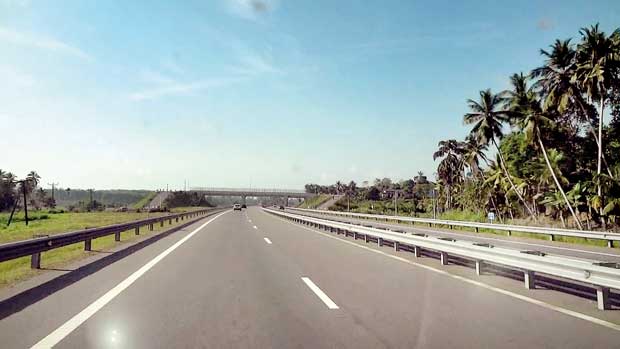
The present Government, after assuming power, was critical of the development projects of the past regime and claimed that they (the projects) had burdened the  country with huge debts. The present regime vowed that the ‘Port City’ and other such projects, which were termed as white elephants, would be stopped. However, work in these projects has continued.
country with huge debts. The present regime vowed that the ‘Port City’ and other such projects, which were termed as white elephants, would be stopped. However, work in these projects has continued.
In 2014 the extension of the Southern Expressway (ESEP) from Matara to Hambantota- including the expressway link to Mattala (96km)- was proposed by the then Government. However, the construction work of the expressway was halted following a change in Government.
The project was launched at an estimated cost of US$1.9 billion or Rs.243 billion.
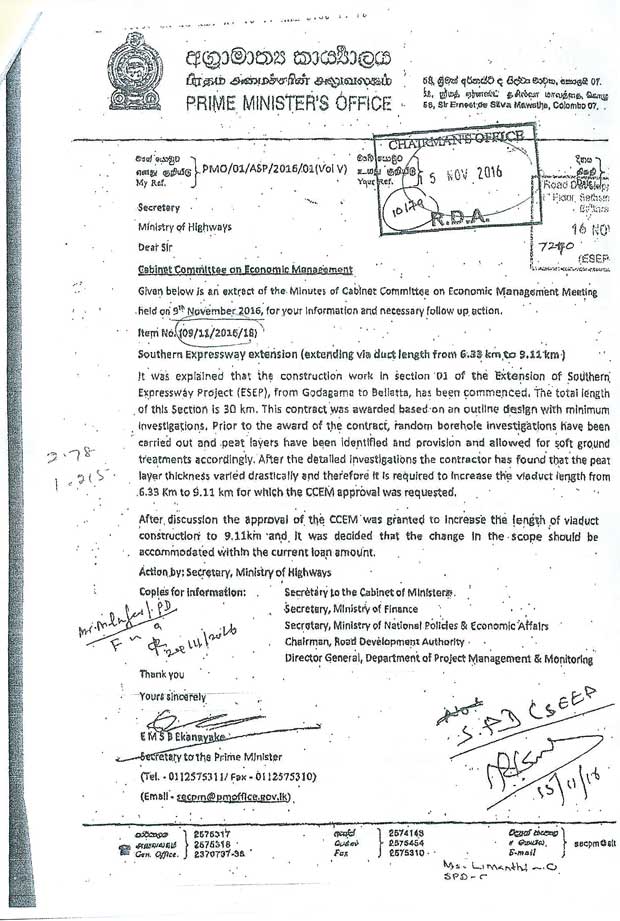
The committee appointed by the Minister of Highways and Investment Promotion gave the options of immediately suspending the project or continuing with the work in keeping with recommendations made by it. Therefore, work on this project recommenced in July 2015.
The project was launched at an estimated cost of US$1.9 billion or Rs.243 billion. These monies were raised through a loan from The Export–Import Bank of China (EXIM Bank) with the Government agreeing to bear 15 per cent of the cost of the first and the second phases.
The 96km long four lane Expressway split into four sections: Matara – Beliatta (30km), Beliatta –Wetiya (26km), Wetiya – Andarawewa (15km) and Mattala – Hambantota via Andarawewa (25km). The expressway section from Matara to Beliatta (Ch.0+000 – Ch.30+000) is under the Extension of Southern Expressway Section 1. The Daily Mirror learns that 35 to 40 percent of the project has been completed.
The contract for section 4 from Mattala to Hambantota via Andarawewa (25km) had been awarded to China Harbour Engineering Company for Rs 52,156mn
The contract for constructing section 1 Matara – Beliatta (30km) had been awarded to China National Aero Technology International Engineering Corporation (CATIC) for Rs 103,280mn.
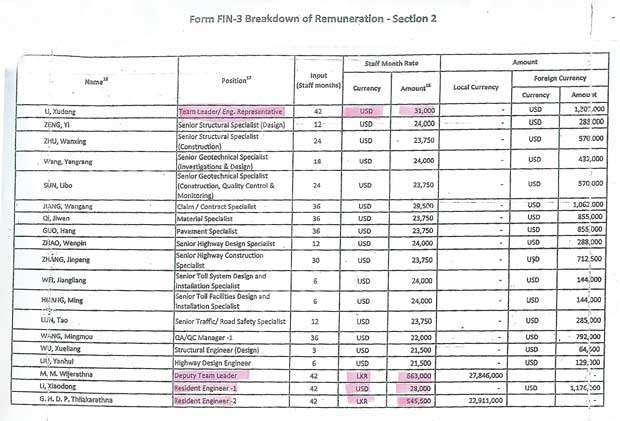
Both contracts of section 2 from Beliatta to Wetiya (26km) and section 3 from Wetiya to Andarawewa (15km) had been awarded to China State Construction Engineering Corporation for Rs 55,200mn and Rs 31,575mn respectively.
The contract for section 4 from Mattala to Hambantota via Andarawewa (25km) had been awarded to China Harbour Engineering Company for Rs 52,156mn.
Feasibility and technical studies
There have been questions raised as to whether a proper feasibility study had been done before the project was commenced.
RDA Chairman N.R.Suriyaarachchi said that there was a feasibility study done by some other institute as directed by the RDA and that he had seen it somewhere. But the RDA chairman failed to name this institute. However Suriyaarachchi said that the RDA takes the responsibility regarding the feasibility study.
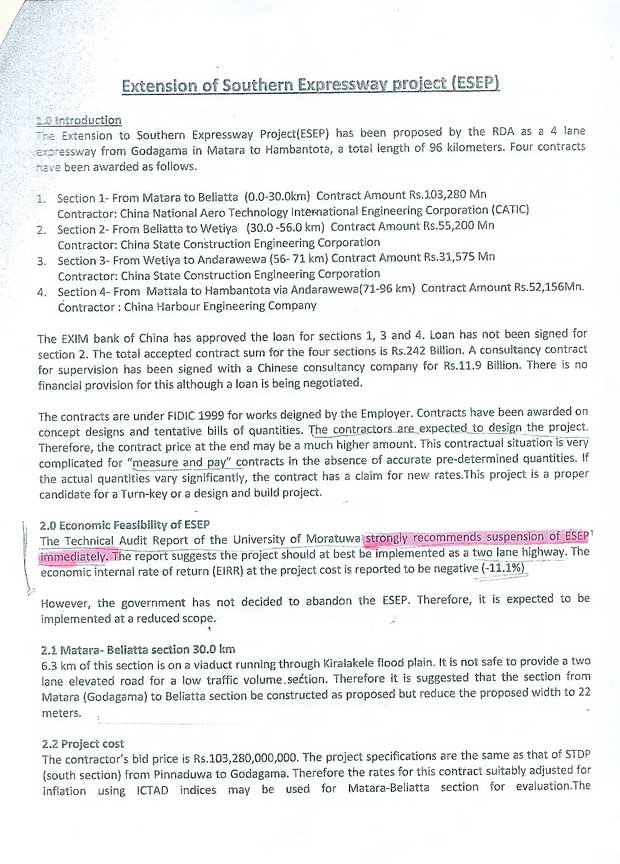
Meanwhile, by issuing a press release on September 27 (Wednesday), Suriyaarachchi said that the construction work was being carried out following studies made by engineers, environmentalists, surveyors, scientists and technicians attached to the RDA, Ministry of Highways, the Central Environmental Authority and the Departments of Land Reclamation and Geology.
“The officials are highly reputed public servants and veterans in their chosen fields of study. They had taken into consideration the weather patterns, flood situations and other natural disasters when compiling their report,” Suriyaarachchi said.
He said that the RDA would implement the project based on a optimum cost system on the instructions of the Ministry of Highways.
Suriyaarachchi said that some people with little or no knowledge of the subject of highways were attempting to mislead the people through disinformation.
The Dailymirror learned during an interview with Suriyaarachchi that a feasibility study had been done at an affordable price since detailed studies cost immensely.
“When it comes to certain detailed studies the RDA can’t bear high costs. Therefore those studies were carried out in the best way possible by a separate institution on behalf of us,” he said.
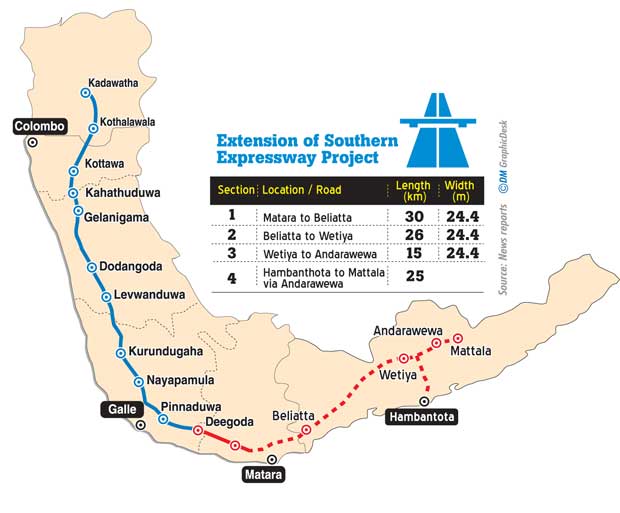
Meanwhile, quoting the technical audit study, carried out by the Moratuwa University, the committee’s “Review of the Highway Project’s Final Report,” issued on April 28, 2015, had stated the audit report had recommended the immediate suspension of the ESEP.
“The report suggests the project should at best be implemented as a two lane highway. The Economic Internal Rate of Return (EIRR) at the project cost is reported to be negative (-11.1%),” the university stated in its Technical Audit Report.
Responding to the matter, the RDA Chairman said that other than the economic viability of the project many other factors have to be considered as well.
The review report stated not to abandon the project, but implement it at a reduced scope.
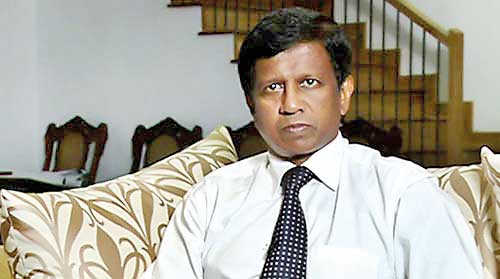 “Journalists should visit the site and report on the development of the project. The RDA guarantees that the construction is underway in keeping with standards. I assure that so far there have been no misconduct. We were a party when constructing the Victoria Tunnel, Kothmale Tunnel and many more. Not a single project went wrong. We have done the construction based on the latest technology. Viaducts were not used in expressways before. Therefore before questions are raised regarding the project the physical work should be monitored. I invite all journalists to visit the project and witness the physical progress,” said Suriyaarachchi.
“Journalists should visit the site and report on the development of the project. The RDA guarantees that the construction is underway in keeping with standards. I assure that so far there have been no misconduct. We were a party when constructing the Victoria Tunnel, Kothmale Tunnel and many more. Not a single project went wrong. We have done the construction based on the latest technology. Viaducts were not used in expressways before. Therefore before questions are raised regarding the project the physical work should be monitored. I invite all journalists to visit the project and witness the physical progress,” said Suriyaarachchi.
The committee had also identified that the 30 km stretch of the Matara to Beliatta section is on a viaduct running through Kiralakele flood plain and suggested to continue the expressway in the form of four lanes. But the committee had recommended to reduce the proposed width to 22 metres. The committee had made this recommendation because it wasn’t safe to provide a two lane elevated road for a low traffic volume section.
Possible financial savings
Apart from the issues associated with the design of the ESEP it is learned that the review committee had suggested ways to possibly make a financial saving amounting around Rs.126 billion.
The report had pointed out that the CATIC (contractor) had made a bid for Rs 103,280mn regarding section 1 on September 20, 2013. The bidder was awarded the contract on October 31, 2013. The report indicates that the project speculations are similar to that of STDP (south section), which runs from Pinnaduwa to Godagama. Therefore concerns had been raised regarding the rates of the contract with recommendations for suitable adjustments for inflation. This was to be done using ICTAD indices and could have been used for Matara to Beliatta section when the evaluation process took place. According to the rate at which the business was confirmed the contract price amounts to Rs 73,892,194,605 which indicates that the contractor’s bid was 40% more than rate specified by STDP.
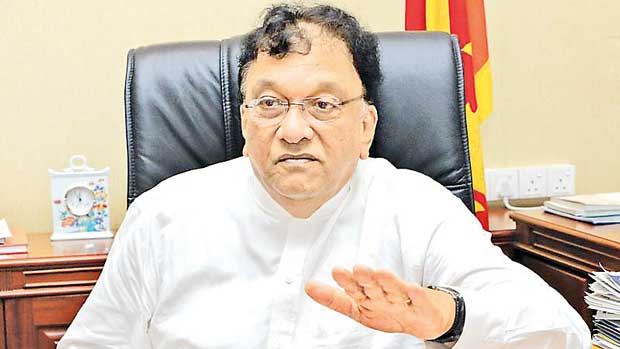 “The matter was raised by Handunnetti and he was playing a political game by trying to find any misconduct thereby gaining advantage by accusing the Government. Over the years parliamentarians were sleeping and raised no objections regarding any subject under the past regime,” charged Minister Kiriella.
“The matter was raised by Handunnetti and he was playing a political game by trying to find any misconduct thereby gaining advantage by accusing the Government. Over the years parliamentarians were sleeping and raised no objections regarding any subject under the past regime,” charged Minister Kiriella.
“If the COPE needs to inquire into any subject it should be based on an Auditor General’s report. However, Handunnetti had decided who is guilty before the judgment. So far during the Unity Government’s two year period the Auditor General hasn’t questioned the RDA nor the ministry’s mega projects. I’m ready to answer any query made by the Auditor General with regard to the subject, but not to Handunnetti. What is Handunnetti’s qualification to question the work of my authority. My officials nor I will answer amateurs. The Speaker of the House advised Hadunnetti not to mention his personnel opinions in Parliament. He instructed him not to have any press conferences regarding the matter.
“COPE is not the police or the CID. What its responsibility is to forward questions based on Auditor General’s Report Queries. So far the Auditor General hasn’t forwarded any observations. It means he doesn’t have any doubts regarding our work as it is transparent.
My officials and I will respond if Handunnetti brings the Audit Reports. We won’t comment on baseless accusations,”said Kiriella.
Apart from section 1, the committee had recommended that it could have saved Rs 123 billion from sections 2, 3 and 4 if they were built as proposed; in two lanes.
Under the proposed two lane facility, including the service roads, the cost of section 2 would be around Rs 7,800mn. This proposal would have saved Rs 47bn.
The report urged that the same two lane facility could have been implemented in section 3 and 4 at a cost of around Rs 4,500mn and Rs 2,700mn respectively. This scheme would have ensured a saving of Rs 27bn and Rs 49bn respectively. Overall there would have been a grand saving of Rs123bn from the entire project.
Also COPE Chairman Sunil Handunnetti told at a recent press briefing that the RDA official’s decisions had given rise to a loss in the suggested saving as it disregarded the committee’s review report. “If their eyes and ears were open it would have not been impossible to make this saving,” he said.
Doubts of international consultants
Also MP Handunnetti charged that the Road Development Authority (RDA) hadn’t screened the expatriates regarding their qualifications or experience when their services were obtained from the Republic of China.
“Employees appointments had been approved placing the entire trust on the contractor. This was done at the risk of the quality and durability of the project,” he said.
According to the ESEP agreement the international consultants should have some experience on the subject. The agreement states that all personnel employed shall have relevant experience connected to expressways.
While rejecting the claims the RDA Chairman said that the Chinese employees were interviewed using video conference facility.
However no assessment has been conducted other than merely referring to their CVs according to a letter sent on September 4, 2015. The RDA Project Director R.M Gamini had approved nine individuals under International Consultants where he stated, “Approval hereby granted to the personnel listed below based on the respective CVs submitted”.
Also local employees had expressed their displeasure over the differences in salary and complained that the package paid to expatriates exceeded the recommended and standard rates applicable in the field.
It was found that the difference in the salary was 1:5 when the pay of a local expert was compared with that of an expatriate.
According to appendix E (services provided by the client) a team leader of the section 2 received a minimum of Rs 4mn (31,000USD) per month while a local team leader was paid only Rs 663,000 per month. Also a foreign Resident Engineer was paid Rs. 3.6mn (28,000USD) while a local Resident Engineer received only Rs 545,500.
The RDA Chairman said that the salary varies depending on the nationality of the employee. He went on to state that an expatriate received minimum of three times the pay paid to a local. He added that the responsibility of paying salaries rests with the contractor and not the RDA.
While rejecting the claims the RDA Chairman said that the Chinese employees were interviewed using video conference facility.
However no assessment has been conducted other than merely referring to their CVs according to a letter sent on September 4, 2015. The RDA Project Director R.M Gamini had approved nine individuals under International Consultants where he stated, “Approval hereby granted to the personnel listed below based on the respective CVs submitted”. Also local employees had expressed their displeasure over the differences in salary and complained that the package paid to expatriates exceeded the recommended and standard rates applicable in the field.
It was found that the difference in the salary was 1:5 when the pay of a local expert was compared with that of an expatriate.
According to appendix E (services provided by the client) a team leader of the section 2 received a minimum of Rs 4mn (31,000USD) per month while a local team leader was paid only Rs 663,000 per month. Also a foreign Resident Engineer was paid Rs. 3.6mn (28,000USD) while a local Resident Engineer received only Rs 545,500.
The RDA Chairman said that the salary varies depending on the nationality of the employee. He went on to state that an expatriate received minimum of three times the pay paid to a local. He added that the responsibility of paying salaries rests with the contractor and not the RDA.
The consultancy service for design review and construction supervision for civil works on ESEP had been awarded to the China Railway First Survey and Design Institute Group Co. Ltd (FSDI) on December 3, 2014 at a cost of Rs 11.9 billion. It was revealed that no loan agreement was signed with EXIM Bank for the consultancy services. Commenting on FSDI operation, Handunnetti said FSDI’s role raises suspicion especially as it had failed earlier in identifying that the viaduct length should be increased from 6.33 km to 9.11km and therefore raising the construction cost. Even though in a situation that the agreement was sealed off, on behalf of the Cabinet Committee on Economic Management, Secretary to the Prime Minister T.B. Ekanayake in a letter on November 13, 2016 to Ministry of Highways Secretary permitted to extend the viaduct length as required.
The letter stated that the changes to the scope should be accommodated within the current loan amount by the company. However, it had been later approved.
According to the original BOQ, the cost for 6.33km was Rs 103,280,000,000 and the FSDI forecast amount for extending it to 9.11km was Rs 126,148,847,447.46.
“A loss of around Rs 23 million was incurred by the decision,” said Handunnetti. However, responding to the matter Suriyaarachchi said that during the past Government the E01Expressway had been constructed without a single viaduct apart from the bridges. He said that in the ESEP the RDA had considered the flood plain in the area and identified the necessity of it.
Meanwhile, Handunnetti charged that the FSDI had violated the country’s emigration and immigration laws when hiring expatriates for the project.
Quoting a letter sent on October 07, 2016 by FSDI General Manager of International Business Division Hang Dong, he said the FSDI had requested permission from R. Paskaralingam, the Senior Advisor to the Prime Minister, to avoid the non-recognition and invalid metering of the expatriates possessing visit visas. The letter states, “In consideration of the client’s urgent requirement and onsite work in progress, FSDI had no choice, but to apply for visit visas or business visas for our engineers to come to Sri Lanka and commence onsite work immediately”. According to the letter no branch office was setup in Sri Lanka at the time when construction of ESEP commenced and the Department of Immigration and Emigration had delayed granting residence visas to these expatriates. There was no mention of Paskaralingam having granted approval or having replied to the letter, but the RDA Chairman said that the directives for the approval were given by the officers’ committee which functions under Paskaralingam.
However, he said that the RDA hadn’t authorized any payment for those who possessed visit visas. He also said that matters regarding such projects should be handled in a sensitive manner as Government to Government (G to G) contracts have been signed. He said that with regard to the ESEP such matters were taken care of by the Special Assignments Ministry, which was under Minister Sarath Amunugama.
Manpower
Also it was reported that several local experts based in foreign countries had shown interest to join the consultancy services, but weren’t given the green light. Some of the local experts who were invited by the RDA had later turned down the invitation due to several incidents being exposed by the media.
MP Handunnetti on several occasions criticized the behaviour of CATIC and RDA officials and said less qualified and less experienced persons had been appointed to the project while qualified (B.Sc) engineers were overlooked. He also said that some local engineers resigned from the project due to alleged malpractices taking place at the project.
It was revealed that 15 local employees, who were working on the project, had reported to the RDA Project Director M.S. Nilawfer of the misconduct of a foreign team leader. A letter signed and dated April 03, 2017 and forwarded by the employees had called for an investigation. These employees have also requested in the letter that suitable action be taken against the team leader regarding 14 incidents of misdeeds carried out by him.
According to the letter the contractor’s attention had been drawn towards suspicious material used in the project. But the team leader had refused to probe the matter. Meanwhile, local engineers said that several failures had been reported in an ongoing construction.
Reportedly cracks were surfacing in a ‘T-girder’ (support beam of the flyovers) giving rise to the fear of a collapsing of the whole flyover, even before construction completes. MP Handunnetti revealed that the contractor had attempted to repair the failures on the sly and that the local consultants were restricted in their observations and in their attempts to enter the mentioned areas. It is also said that they were threatened by the team leader when they were attempting to gain access to the site.
“No action has been taken regarding the mentioned team leader’s decisions nor regarding the contractor in connection with the local consultant staff who had resigned from their portfolios,” MP Handunnetti said. Also the service of the two complainants D.D.J.A. Amarasena (Quantity Surveyor) and W. Hasantha Fonseka (Geotechnicle Engineer) had been terminated without the RDA’s consent by the consultancy company. The Senior Geotechnical Engineer Dr. N H Priyankara stepped-down from his position with effect from July 05, 2017 after the local engineers exposed the misconducts that happened at the ESEP.
When inquired the RDA Chairman said that the employees were bound by their sub-contractor who works under the main contractor. He said that therefore the RDA doesn’t hold any responsibility regarding them. However, he said that the RDA would investigate into the misconducts mentioned in the letter.
Tax concessions and imports
In a letter dated 13.07.2015 by the Director General of the Department Of Fiscal Policies to the Director General of the Inland Revenue had given instructions regarding the tax concessions granted on the ESEP.
It indicates that the importation of steel and passenger transport vehicles is exempted from the tax concessions.
Clause 04 (ii) -- “Steel is treated as an item which is in the negative list. Therefore, importation of steel is not exempted from taxes. However, the local purchase of steel is eligible for SVAT facility and exemption from NBT, if purchased for a strategic Development Project,”
Clause 05 (ii) – “Tax exemptions/ deferments are not entitled for the importation of any vehicles used for passenger transportation,” the letter further said.
Even though it had been clearly stated that the passenger vehicles weren’t exempted from tax the CATIC (constructor) had requested a duty wavier for the import of a Mercedes Benz. CATIC had mentioned that the vehicle was for the project via a letter sent to the RDA Senior Project Director R.M Gamini on November 21. 2016.
“Hereby the contractor would like to inform employer that one unit Mercedes Benz Vehicle has been imported by Contractor for the purpose of project use and will arrive at Colombo Port on November 21.2016,” the letter said.
However, following media exposure, the vehicle was released to CATIC after paying the due duties. But it was learned that the company can’t purchase any vehicle under its name as per the agreement. According to the agreed terms whatever vehicle used in the project should be purchased under the state authority and should be handed over once the project is completed. It was also stated that the tax regarding some spine piles (under B/L no YD1702TJCO17) has been waived off on approval of the RDA despite it being clearly stated that tax exemptions/deferments aren’t entitled when importing steel. Responding to the matter the RDA Chairman said that the subject doesn’t come under his purview.
Meanwhile, heated arguments had ensued between Highways Minister Lakshman Kiriella and COPE Chairman Handunnetti in Parliament, regarding the matter. MP Handunnetti questioned the minister over several matters connected with the project, but the minister refused to respond. Minister Kiriella claimed that he nor his officials would comment on the matter unless COPE questions are based on an Auditor General’s report.
21 Dec 2024 5 hours ago
21 Dec 2024 21 Dec 2024
21 Dec 2024 21 Dec 2024
21 Dec 2024 21 Dec 2024
21 Dec 2024 21 Dec 2024